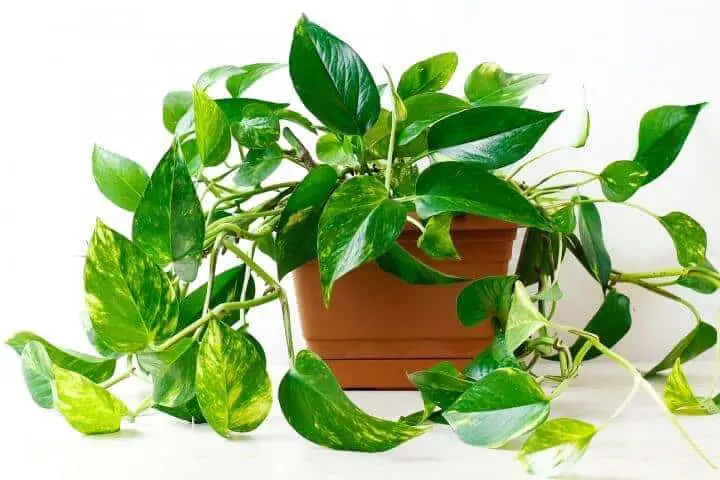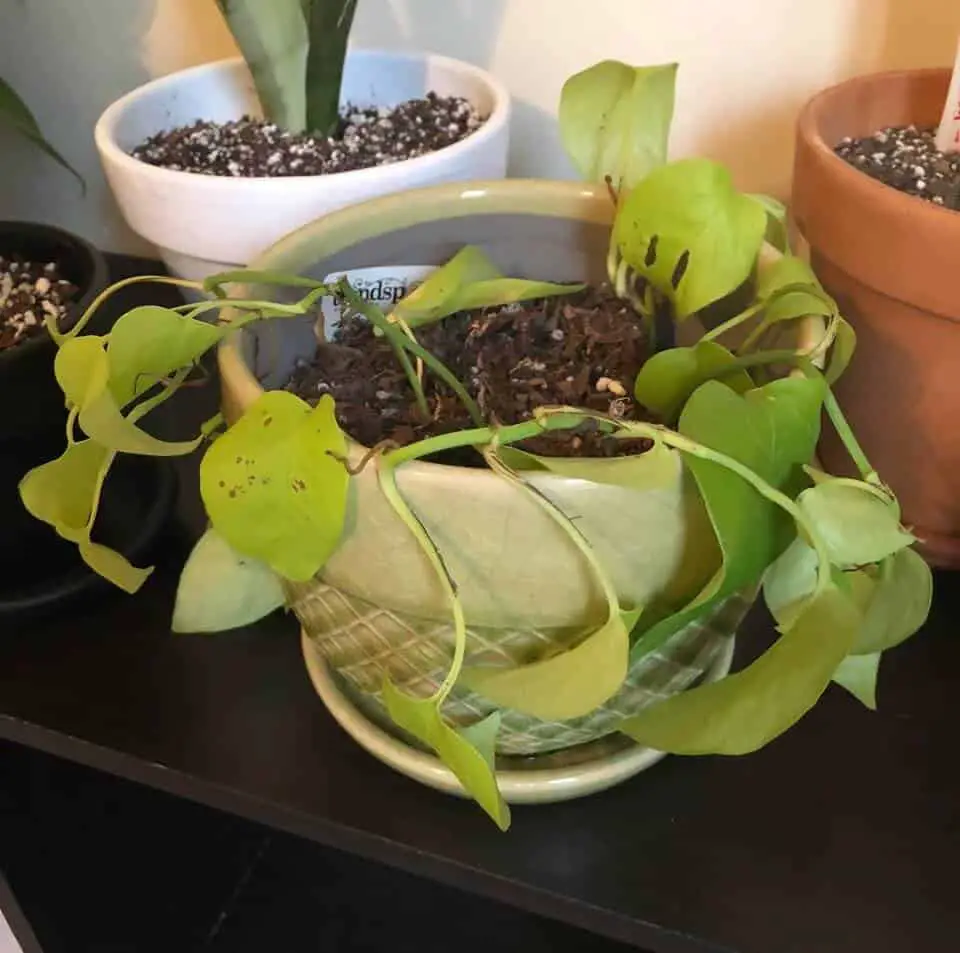Contents
When nature-lovers want to bring greenery to their home, they opt for beautiful household plants. One of the most popular choices is the pothos plants. The reason why almost every household has a pothos plant is because they’re indoor plants and easy to maintain.
Some of the most popular types of pothos plants are Golden pothos, Marble Queen, and Jade pothos. Pothos plants are the best recommendation for your home and office. They grow easily with minimal requirements and also have a fair share in protecting the environment. They add a touch of freshness to your surroundings.
What Exactly Are Pothos Plants?
Pothos plants are basically household plants and are also called Golden pothos, Money plant, and Devil’s Ivy. These heart-shaped leaves come from the arum family. Indoors, pothos plants can grow to about 6 to10 feet over time, and the best way to grow them is in a hanging container. While its scientific name is Epipremnum aureum, the other interesting name, Devil’s Ivy, is because these plants are almost impossible to kill, and they have the ability to survive even in the dark.
Pothos leaves are variegated in white, yellow, or green leaves and are the most popular houseplants in North America. They are evergreen climbers but do not produce flowers in the juvenile phase. Although they are effortless to grow, plant growth can still be hampered because of various reasons.

Golden Pothos (Image Source- Almanac)
Why Do Pothos Leaves Turn Yellow And How To Fix It?
It’s common to face the problem of pothos leaves turning yellow, and there can be a lot of reasons:-
1. Too Much Sunlight
It may seem odd how too much sunlight can be bad for plants. However, pothos plants are one of those household plants that can turn yellow if they’re overexposed to direct sunlight. They’ll start to show signs of burning by turning yellow.
- How To Fix It?
Shift your plant to a shadier place and make sure plant is getting indirect sunlight. Since pothos is a low-light plant, you can place it in an area where it doesn’t get direct sunlight. You can avoid east-facing windows since sunlight may be too strong there. Besides, you can also use a sheer curtain in the area to avoid the entry of direct sunlight.
2. Overwatering
One of the most common causes of pothos leaves turning yellow is too much moisture or not enough moisture. Poor drainage can be blamed for not letting the excess water drain into the saucer. If it’s left like that, the soil will be too wet, which will cause the root rot. Once the rotting starts, the plant won’t be able to get essential nutrients. Thus, this will cause the leaves to turn yellow.

Overwatered Neon Pothos (Image Source- Reddit)
- How To Fix It?
First thing first, make sure you practice proper drainage with your pothos and maintain watering schedule. Don’t allow the saucer to overflow. If the saucer is filled with water, immediately dump it. Additionally, you can give time to the soil to dry. To check if it needs water again, insert your finger into the pot and if it comes out dry, pour some water, and practice proper drainage. However, if roots seem to be rotten, uproot the plant and cut out the damaged roots leaving the healthy ones in.
3. Excess/Lack Of Fertilizer
The plant lovers want to ensure that their pothos’ grow in the best way, but too much love or not enough love can severely hamper its quality. When we give too much fertilizer to pothos, it starts to build up in the soil, which results in the yellowing of the leaves. Similarly, a nutrient deficiency will impact the chlorophyll production, and the yellowing will start to show.
- How To Fix It?
For starters, you can wet the soil multiple times and let it drain, or you can just change the soil of your pothos. To prevent this in the future, give your pothos the correct type of quality fertilizer once every two months. Maintain a calendar so that you don’t over-fertilize or under-fertilize it.
4. Improper Temperature
It’s essential that your pothos plant is neither in a too cold place nor in a too hot place. If you’ve been keeping your plant too close to a window or too close to a fireplace, you might want to reconsider its placement. The ideal temperature for a pothos plant to thrive is between 70 degrees Fahrenheit and 90 degrees Fahrenheit. It can grow at 50 degrees Fahrenheit as well. However, anything below 50 degrees Fahrenheit or above 90 degrees Fahrenheit will affect the tissues of the leaves, and they’ll turn yellow.
- How To Fix It?
Place your plant in an area with moderate temperatures. Make sure you avoid those places where the temperature fluctuates a lot. To avoid this in the future, keep a watch on your plant when you change its surroundings, and ultimately you’ll find an ideal spot.
5. Renewal
Yellowing of pothos leaves is really common when the older leaves are aging and dropping off. In this case, the leaves are just making way for new leaves. If you see the bottom leaves turning yellow, it means that new foliage will grow soon.
How To Take Proper Care Of Pothos Plants?
Pothos plant are very easy to maintain, and here are a few ways in which you can take care of them:-
- Sunlight: Pothos plants are to be kept in low-light areas for ideal growth. They can be grown in the shade or partially shady places.
- Watering: Make sure that you water your pothos plants once every two months. Maintain a proper drainage system and watering schedule. You’ll be good to go.
- Fertilizing: Pothos don’t require a huge amount of fertilizer. Feeding them with a good houseplant fertilizer every month will be enough.
- Pruning: The stems of a pothos plant can be trimmed to keep the plant bushy. However, if you want a vine-like appearance, let the plant grow naturally.
- Repotting: When you notice that your pothos leaves are drooping no matter how much you water them, it probably means that the roots have filled the pot. In that case, carefully pour it into a bigger container with fresh soil.
For more information on how to take care of your pothos plants, you can check out this youtube video.
Advantages Of Keeping Pothos Plants At Home
- Purification Of The Air
A NASA study has identified various household plants that help purify the air at home, one of which is Golden pothos. It eradicates benzene, carbon monoxide, and formaldehyde, which are often found in newly painted rooms. Since there are high chances that exhaust fumes might be found at the entryways or the garage area, we recommend placing your pothos plants there.
- Versatile In Nature
Since pothos plants are low-light plants, you can creatively decorate them at your home. You can hang them or place them on the table. You can even let them grow beautifully in your garden. You can also grow them in different types of containers like in a Mason Jar, in little plastic cups, in an aquarium, and so on.
- An Anti-Radiator
Pothos plants reduce radioactive emissions at homes and offices coming from mobile phones, laptops, and televisions.
Pothos Plants All The Way
To sum up, pothos plants are one of the best plants to grow at your home. They’re low maintenance and act as a great air purifier. There are many ways to save them if leaf yellowing and prevent the same from happening in the future. I hope this article has helped you with the information you were looking for.
Want to know more about gardening ?
Fill in your email address in the form below and you'll receive all the latest updates directly in your in-box.
Thank you for subscribing.
Something went wrong.